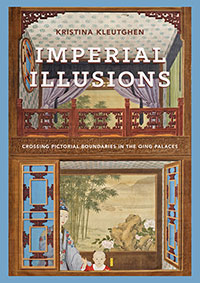Kristina Kleutghen, PhD, has been selected as the inaugural David W. Mesker Career Development Professor of Art History at Washington University in St. Louis. A lecture and reception to celebrate her appointment was held Feb. 25 at the Mildred Lane Kemper Art Museum.
A specialist in early modern and modern Chinese art, Kleutghen joined the Department of Art History and Archaeology in Arts & Sciences in 2011 as assistant professor. Her research investigates Sino-foreign interaction, the imperial court, optical devices, and connections to visual culture, science and mathematics.
Kleutghen’s endowed position was made possible by a gift from David W. Mesker in 2014. A strong proponent of the arts, Mesker established the professorship at Washington University to support outstanding scholars in the Department of Art History and Archaeology whose studies include the history of Chinese and Japanese painting.
“I am deeply grateful to David Mesker for this professorship, which underscores his commitment to the arts and to teaching and scholarship at Washington University,” Chancellor Mark S. Wrighton said. “He is a tireless advocate, both for the arts in all their diversity and for St. Louis.”
“It is a distinct pleasure to have this opportunity to recognize Kristina Kleutghen’s contributions as a gifted scholar as well as a remarkable teacher and mentor, with the David W. Mesker Career Development Professorship,” said Barbara A. Schaal, PhD, dean of the Faculty of Arts & Sciences and the Mary-Dell Chilton Distinguished Professor. “She is a terrific asset both to the Department of Art History and Archaeology and to Arts & Sciences.”

Kleutghen’s first book, “Imperial Illusions: Crossing Pictorial Boundaries in the Qing Palaces” (University of Washington Press, 2015), examines all known surviving examples of the Qing court phenomenon of “scenic illusion paintings,” or tongjinghua, which today remain largely inaccessible inside the Forbidden City.
Produced at the height of early modern cultural exchange between China and Europe — by artists of the imperial painting academy and by European missionary painters — these monumental works employed Western perspectival illusionism to transform walls and ceilings with visually striking images. Although they have received little previous scholarly attention, the paintings provide new insights into the life of Emperor Qianlong
(r. 1736-1795), one of the period’s most influential figures, and into the ways Chinese art integrated and domesticated foreign ideas.
A second monograph project, “Lens onto the World: Optical Devices, Art, Vision, and Visuality in China,” is currently in progress. The book will examine the effects of domestically produced optical devices and art on vision, society and science from the 16th through early 20th centuries.
Kleutghen earned a bachelor’s degree in Asian and Middle Eastern studies from Dartmouth College in 2003 and master’s and doctoral degrees in history of art and architecture from Harvard University in 2005 and 2010. She studied in Chinese language at Tsinghua University in Beijing from 2005-07.
“Professor Kleutghen is especially interested in questions of how China’s complex relationship with Europe in the early modern era informs the political, social and aesthetic development of art,” said Elizabeth Childs, PhD, chair of the Department of Art History and Archaeology and the Etta and Mark Steinberg Professor of Art History. “She is also extremely effective in teaching from original works of art, and makes tremendous use of our local resources. Our students are enormously privileged to work with her.”
Kleutghen’s research has been supported by the Blakemore Foundation, the Andrew W. Mellon Foundation, the National Endowment for the Humanities and the Getty Research Institute.
About David W. Mesker
A native of St. Louis and avid supporter of the arts, Mesker is a retired treasurer and senior vice president of A.G. Edwards.
Mesker left his hometown to attend Amherst College, where he earned his undergraduate degree in 1953, then went on to spend three years in the U.S. Army’s Counter Intelligence Corps before returning to St. Louis, where he would spend five years at Mesker Brothers Iron Works before taking a position at A.G. Edwards in 1962. He would spend the next 35 years at the company before retiring in 1997. In addition to his leadership roles, Mesker helped to build the company’s art collection, including many early St. Louis scenes, and took part in developing the master plan for the company’s campus.
A longtime advocate for the region, Mesker’s support extends to many organizations and causes where he has held key volunteer roles, such as Webster University, the St. Louis Symphony, Opera Theatre of St. Louis and the Gateway Mall Conservancy Board, among others. For Washington University, Mesker has served on the Sam Fox School of Design & Visual Arts National Council and on the Mildred Lane Kemper Art Museum’s Collection Committee.
In addition to the Mesker Professorship, his philanthropic support to Washington University includes contributions to both the Sam Fox School of Design & Visual Arts and the Mildred Lane Kemper Art Museum. Mesker and his partner, Dorothy Haase, an artist, have also made a promised gift to the university, a sculpture of Mesker’s head created by Haase, which will reside with the holder of the Mesker Professorship in the Department of Art History and Archaeology.